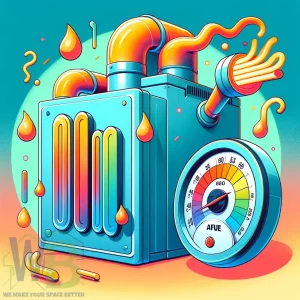Thermostats work by regulating the temperature in a heating or cooling system. There are different types of thermostats, including mechanical and digital models.
In this article, we’ll explore the fascinating world of thermostats, unveiling their vital role in our daily lives.

Quick Summary
| Section | Focus | Key Points |
|---|---|---|
| What is a Thermostat? | Role and Function | – Controls temperature in various systems – Found in homes, cars, appliances – Enhances comfort and energy efficiency |
| How Does a Thermostat Work? | Operation Mechanism | – Uses materials sensitive to temperature changes – Automatically adjusts heating or cooling |
| Car Thermostats | Engine Temperature Control | – Regulates coolant flow – Quick engine warm-up – Wax-filled cylinder mechanism – Essential for engine health and efficiency |
| Home HVAC Systems Thermostats | Home Climate Control | – Regulates home temperature – Uses bimetallic strip or sensors – Programmable, Wi-Fi capable, smart integration |
| Heating Thermostats | Controlling Indoor Warmth | – Regulates indoor heating – Bimetallic strip or thermistor-based – Digital advancements for precision |
| AC Thermostats | Cooling Systems | – Monitors and controls AC systems – Uses thermistors for accuracy – Digital, programmable, and smart home integration |
| Household Appliance & Equipment Thermostats | Appliance Temperature Regulation | – Ovens and refrigerators: bimetallic strips, bellows – Coffee pots, hair dryers: safety and precision – General mechanism: temperature-sensing for control |
| Conclusion: How Thermostats Work | Summary and Impact | – Integral in everyday life for temperature regulation – Mechanical and digital systems – Enhance safety, comfort, and energy efficiency |
What is a Thermostat?
Think of a thermostat as a temperature detective. It checks and adjusts the heat or cold in places like your home, car, or fridge to keep things comfy and efficient.
Key Roles of a Thermostat:
- Temperature Regulation: Keeps environments at desired temperatures.
- Widespread Use: Found in homes, cars, and various appliances.
- Efficiency and Comfort: Ensures energy efficiency and personal comfort.
How Does a Thermostat Work?
A thermostat senses temperature changes. It uses special materials that grow or shrink with heat or cold to start up heating or cooling systems. This clever design keeps the temperature just right.
How It Functions:
- Temperature Sensitivity: Uses materials responsive to temperature changes.
- Automatic Adjustment: Activates heating or cooling to correct deviations.
Car Thermostats: Engine’s Temperature Control
Car thermostats are important parts that help keep your car’s engine running at its best.
The Role of a Car Thermostat
- Temperature Regulation: A car thermostat controls the coolant flow to the radiator. This keeps the engine at the right temperature, usually around 200 degrees Fahrenheit (95 degrees Celsius). This control is important for your car to work well and last longer.
- Quick Engine Warm-up: The thermostat makes the engine warm up quicker by managing the temperature. This does more than just heat up your car faster. It also cuts down on engine wear, stops the buildup of deposits, and lowers emissions.
The Mechanics of a Car Thermostat
- Design and Size: The thermostat is typically a small device, about 2 inches (5 cm) in diameter. Its compact size belies its significant role in engine performance.
- Wax-Filled Cylinder Mechanism: Inside the thermostat is a cylinder filled with wax. This wax plays a vital role in the thermostat’s operation. When the engine is cold, the wax inside the thermostat is solid. But the wax melts at a specific temperature as the engine heats up.
- Valve Operation: As the wax melts, it expands. This expansion is used to push against a rod, opening a valve. When this valve opens, the coolant flows into the radiator. This process is essential for preventing the engine from overheating.
- Maintaining Optimal Temperature: When the engine reaches the right temperature, the thermostat keeps it steady. It opens and closes a valve to control the coolant flow. If the engine cools down, the wax inside becomes solid, closing the valve. This keeps the engine’s temperature stable, which is key for it to run well.
Why is a Car Thermostat Important?
- Engine Health: A good thermostat is important for keeping your engine healthy. It helps the engine warm up fast and stay at the right temperature, which prevents damage from getting too hot or too cold.
- Fuel Efficiency and Emissions: The thermostat in your car helps it save fuel and reduce pollution by maintaining the correct temperature. When the engine is too cold, it uses more fuel and creates more pollution. If it gets too hot, it can get damaged.
The car thermostat is tiny, but it greatly affects your engine. It shows how a simple, well-made part can be important for modern machines like cars.
It keeps your engine at the right temperature, which makes your car last longer, use less fuel, and be kinder to the environment.
Home HVAC Systems Thermostats
Home HVAC thermostats do more than just control temperature. They are like your climate system’s brain, ensuring your home stays comfortable.
The Basic Function of Home Thermostats
- Temperature Regulation: The main job of a home HVAC thermostat is to keep the room at the temperature you want. It watches the room’s temperature and turns on the heat or air conditioning to make it just right.
- Heating and Cooling Activation: The thermostat turns on the AC or heater when the indoor temperature exceeds what you want. This keeps your home comfy no matter how hot or cold it is outside.
The Mechanics Behind Thermostats
- Temperature-Sensing Components: Older thermostats usually have a bimetallic strip or a mercury switch to sense temperature. The strip, made of two metals, changes shape when it gets hot or cold. This change in shape either turns the HVAC system on or off by opening or closing an electrical circuit
- Bimetallic Strip Functionality: When you want to warm up a room, a special bimetallic strip helps. It allows electricity to flow and start the heating system. As the strip gets hotter, one of its metal parts grows bigger. This stops the electricity, and the heater turns off to cool the room.
Modern Digital Thermostats
- Digital and Sensor-Based: Modern thermostats have primarily transitioned to digital technology. They use sophisticated sensors to gauge the room temperature accurately. This has dramatically improved the precision and efficiency of home HVAC systems.
- Programmable Settings: One of the key advancements in thermostat technology is the ability to program settings. Homeowners can set different temperatures for different times or days of the week. This not only enhances comfort but also improves energy efficiency.
- Wi-Fi Capabilities and Smart Home Integration: Today’s thermostats can connect to Wi-Fi, which means you can use your phone or other devices to change the temperature in your house. They also work with other smart home stuff, so you can set them up to fit your life and how you like things.
- Learning Abilities: Some advanced thermostats even have learning capabilities. These thermostats can learn your daily schedule and change the temperature to keep you comfy and save energy. You don’t have to keep adjusting them yourself.
Importance in Home Comfort and Energy Efficiency
- Comfort Management: Thermostats help keep your home comfortable by keeping the temperature steady.
- Energy Conservation: Programmable and smart thermostats save energy by making heating and cooling times more efficient.
The thermostat in your home’s HVAC system does more than just control the temperature. It’s a smart device that keeps you comfy while saving energy.
As technology improves, these devices get smarter and give you more control and convenience for your home.
Heating Thermostats: Controlling Indoor Warmth
Heating thermostats are essential in maintaining comfortable indoor environments, particularly in cooler climates.
They function by precisely regulating the temperature of a space. Let’s explore the mechanics and modern advancements in heating thermostat technology.
Basic Functioning of Heating Thermostats
- Temperature Regulation: The core function of a heating thermostat is to control the indoor temperature. It does this by sensing the current temperature and activating the heating system when necessary to reach the desired level.
- Types of Thermostats: Most heating thermostats have a secret detective inside called a sensor. This sensor can be like a flexible strip that bends with temperature or a special “thermistor” that changes its code. The sensor sends a message when the room gets chilly, and the thermostat tells the furnace to get things toasty! It’s like a temperature conversation keeping your home just right.
Traditional Thermostat Mechanisms
- Bimetallic Strip: The strip comprises two metals bonded in a bimetallic strip-based thermostat. When heated, these metals expand at different rates, causing the strip to bend. This bending movement makes or breaks an electrical circuit, which controls the heating system.
- Operation Cycle: The bimetallic strip cools down and shrinks when it gets colder. This action closes the circuit and starts the heating system. When the room warms up and hits the chosen temperature, the strip expands and opens the circuit, stopping the heater to avoid overheating.
Advancements in Modern Thermostats
- Digital Thermostats: The shift towards digital technology in thermostats has significantly improved temperature regulation. These modern thermostats use electronic sensors for more accurate temperature readings.
- Programmable Features: One of the standout features of digital thermostats is their programmability. Users can set specific temperatures for different times or days of the week, aligning heating patterns with their daily schedules and preferences.
- Wi-Fi Connectivity and Smart Integration: Most modern heating thermostats can connect to Wi-Fi, so you can control them remotely using your smartphone or other devices. This is useful for changing the temperature when you’re not at home or keeping an eye on your energy usage.
- Smart Learning Functions: Some advanced models can learn from user behavior, automatically adjusting settings based on observed patterns. This smart functionality ensures optimal comfort without the need for constant manual adjustments.
The Impact of Heating Thermostats on Home Comfort and Energy Use
- Enhanced Comfort: Maintaining consistent warmth; heating thermostats are crucial in creating a cozy and inviting home environment.
- Energy Efficiency: Programmable and smart thermostats contribute significantly to energy conservation. They optimize heating times and temperatures, reducing unnecessary energy consumption and lowering utility bills.
Whether old or new, heating thermostats are important for keeping your home warm and saving energy. Recent improvements make them easier to use and give you more control over your home’s heating.
They provide warmth and comfort and contribute to smarter, more sustainable energy use.
AC Thermostats: Masters of Cool Comfort
AC thermostats are important for keeping indoor spaces cool on hot days.
These devices are designed to sense and control the temperature within a space, ensuring comfort and efficient energy use.
Functionality of AC Thermostats
- Temperature Sensing and Control: The main job of an AC thermostat is to watch the room temperature and turn on the air conditioner when it gets warmer than the chosen temperature. This keeps your indoor environment comfortable all the time.
- Digital Technology in Temperature Measurement: Modern AC thermostats use digital technology for precise temperature measurement. They are equipped with a component called a thermistor, a type of resistor whose electrical resistance changes with temperature fluctuations.
How Digital AC Thermostats Work
- Thermistor Mechanism: The thermistor in an AC thermostat is sensitive to temperature changes. As the room temperature varies, the electrical resistance of the thermistor changes accordingly.
- Microcontroller-Based Measurement: A microcontroller within the digital thermostat measures the thermistor’s resistance. This resistance is then converted into a temperature reading, which is used to determine whether the cooling system needs to be activated or deactivated.
- Temperature Regulation Cycle: When the indoor temperature exceeds the desired setting, the thermostat triggers the air conditioning system to cool the space. Conversely, when the set temperature is achieved, the thermostat will signal the AC system to turn off or reduce its cooling output, thus maintaining the set temperature efficiently.
Advantages of Digital AC Thermostats
- Precision and Efficiency: Digital technology in AC thermostats allows for more accurate temperature readings and control. This precision helps maintain a comfortable indoor environment more effectively and can lead to more efficient energy usage.
- Programmability and Smart Features: Many digital thermostats offer programmable options, allowing users to set specific temperatures for different times or other days of the week. This feature is particularly beneficial for managing energy usage when the space is unoccupied.
- Integration with Smart Home Systems: Advanced AC thermostats can be integrated with smart home systems, providing remote control and monitoring capabilities. Users can adjust settings through smartphones or voice commands, adding convenience and optimizing energy usage.
Impact on Comfort and Energy Conservation
- Enhanced Indoor Comfort: AC thermostats are essential in providing comfort during hot weather by maintaining a stable and cool environment.
- Optimized Energy Use: Smart and programmable features in digital thermostats contribute to significant energy savings by reducing unnecessary cooling when it’s not needed.
AC thermostats, particularly those with digital technology, are integral to modern air conditioning systems. They ensure that our living and working spaces remain comfortable while playing a key role in energy conservation.
As technology advances, these thermostats are becoming more sophisticated, offering greater control, convenience, and efficiency in managing indoor climates.
Household Appliance & Equipment Thermostats
Thermostats in household appliances and equipment are essential for regulating temperature and ensuring efficiency, safety, and optimal performance.
From kitchen equipment like ovens and refrigerators to everyday appliances like coffee pots and hair dryers, thermostats play a crucial role.
Kitchen Equipment Thermostats
- Ovens: In ovens, thermostats are vital for controlling the cooking temperature. Many electric ovens use bimetallic strips in their thermostats. These strips bend as they heat up, breaking or making electrical contact, thus regulating the temperature. Gas ovens often use an invar rod, a metal that expands predictably with heat, to control the gas flow and, consequently, the temperature.
- Refrigerators: Refrigerators use a different type of thermostat known as a bellows or pressure thermostat. This system involves a long, thin tube filled with a fluid or gas that expands or contracts with temperature changes. The tube is connected to a bellows, a flexible chamber that moves in response to the fluid or gas’s expansion or contraction. This movement then opens or closes electrical contacts to maintain the desired temperature inside the refrigerator.
Thermostats in Household Appliances
- Coffee Pots: In coffee makers, thermostats play a critical role in heating water to the optimal temperature for brewing coffee. This ensures not only the right taste but also the safety of the appliance by preventing overheating.
- Hair Dryers: Hair dryers use thermostats to regulate the blown-out air temperature. This is crucial for user safety, preventing the air from getting too hot and potentially causing burns or damaging the hair.
General Mechanism in Appliance Thermostats
- Temperature-Sensing Components: Regardless of the appliance, thermostats typically utilize temperature-sensing components that respond to changes in temperature by either breaking or making an electrical circuit.
- Control of Heating or Cooling Systems: These components effectively control the appliance’s heating or cooling system, ensuring the desired temperature is consistently maintained.
- Safety and Efficiency: In addition to maintaining desired temperatures, thermostats in household appliances are crucial for ensuring safety by preventing overheating and enhancing energy efficiency by avoiding unnecessary energy consumption.
Thermostats in household appliances and HVAC equipment illustrate the remarkable application of temperature regulation technology in our daily lives. They facilitate the efficient operation of appliances and significantly contribute to safety and energy conservation.
As technology advances, the integration and sophistication of thermostats in household devices continue to evolve, further enhancing their functionality and user convenience.
Understanding the Mechanics of How Thermostats Work
Thermostats work in many things, like your home stuff and air conditioning, and they do it simply, precisely, and high-tech. These little machines are important, even though we pay little attention to them.
They quietly and effectively control the temperature in our homes and gadgets.
The Role of Thermostats in Everyday Life
- Temperature Regulation: Thermostats help keep things at the right temperature. They work in cars, heaters at home, and kitchen gadgets. They make sure things stay comfy, safe, and work well.
- Energy Efficiency: Thermostats help save energy and money by controlling when and how heating or cooling systems work.
- Safety and Comfort: In household appliances, thermostats prevent overheating, ensuring safety. In HVAC systems, they maintain a comfortable indoor environment.
The Technology Behind Thermostats
- Mechanical and Digital Systems: Thermostat technology varies, but its main goal is always to control temperature accurately. It can be found in things like bimetallic strips in ovens and digital sensors in smart home systems.
- Advancements and Smart Features: Today, new thermostats have fancy features like digital sensors and smart tech. You can program them, control them from far away, and they even learn to make things better for you.
Final Thoughts
Thermostats do their job quietly and well; they’re a big part of our modern lives. They can sense and react to temperature changes using simple or high-tech methods, a cool mix of science and engineering.
As we keep making new tech for our lives, thermostats show how far we’ve come in making temperature control better and easier. Learning how they work makes us see how smart design matters in everyday tech. They’re a great example of how a little thing can make a big difference in how comfy, safe, and energy-efficient our lives are.







